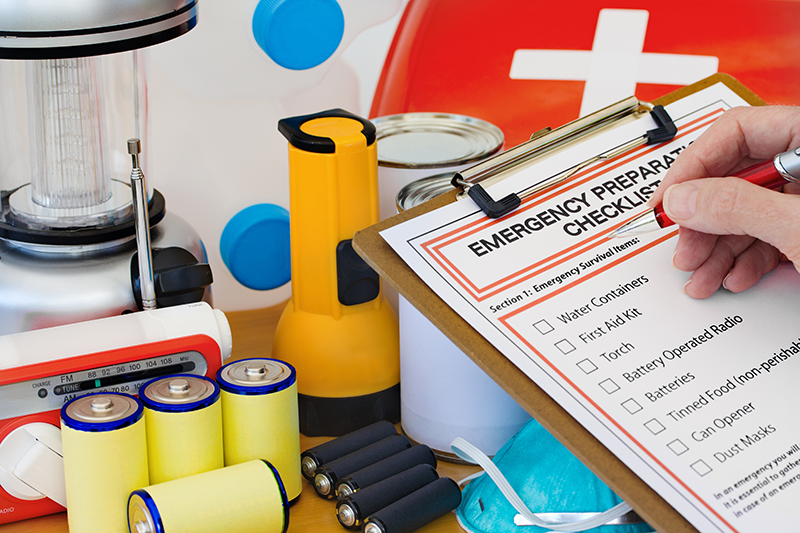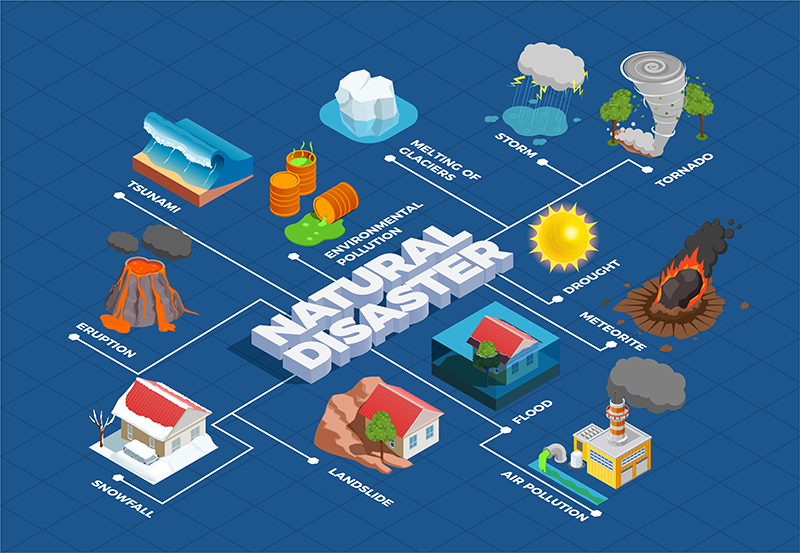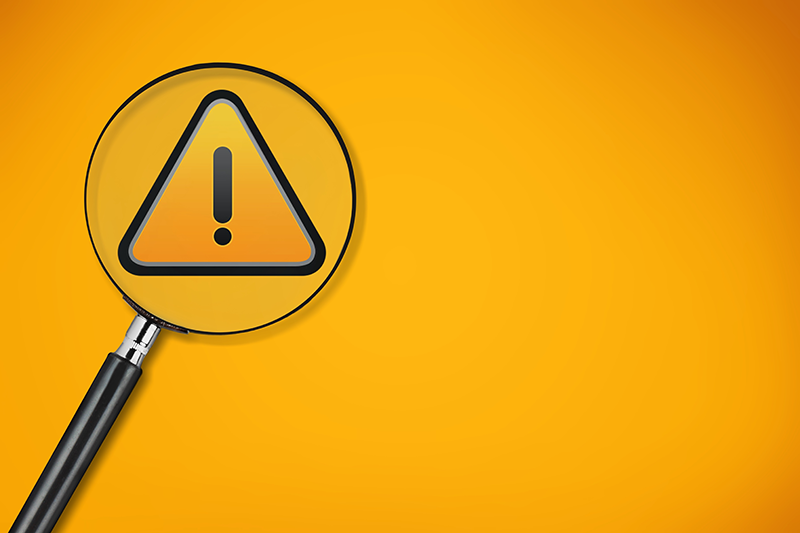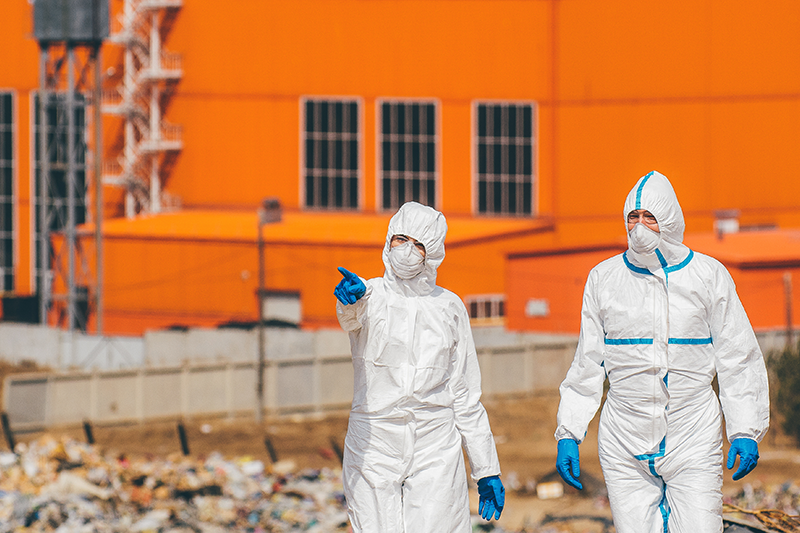Disaster Preparedness and Response
The following resources are provided to assist animal care and use programs in preparing for and coping with disasters and emergencies while maintaining animal welfare.
A note on terminology: Several definitions of "disaster" exist, including legal definitions and those from nongovernmental entities. This page primarily uses the term “disaster” as found in the Guide for the Care and Use of Laboratory Animals (Guide p.35), but the principles provided may be equally applicable to many types of emergencies.
On this page:

What is a Disaster?
Disasters are “unexpected conditions that result in the catastrophic failure of critical systems or significant personnel absenteeism, or other unexpected events that severely compromise ongoing animal care and well-being" (Guide p.35).
It can be helpful to think of disasters or emergencies in general categories:
- Natural Disasters: Hazardous events occurring due to environmental factors, such as floods, hurricanes, tornadoes, heat waves, etc.
- Accidents: Unexpected, unintentional events that result in negative consequences, such as equipment failure, release of hazardous material, human error, etc.
- Malicious Events: Deliberate actions of ill intent designed to cause harm or damage, such as vandalism and sabotage, cyberattacks, terrorism, etc.
- Biological Events: Hazardous events occurring due to biological factors, such as pandemics, facility disease outbreaks, large-scale pest or mold infestation, etc.
Some disasters, such as weather events, can be anticipated to some degree. Others may occur with little warning. Disasters or emergencies may also vary in scale and result in localized or more extensive effects; for example, one storm may produce limited flooding or HVAC failure in a single vivarium building, while another may result in a large tornado that produces widespread damage. A disaster or emergency need not be extensive to have a significant impact on the welfare of animals and the research program. Having a well-designed disaster plan that addresses multiple types of disasters can help minimize potential impacts to life, property, and program operations.

Quick References
OLAW provides external resources as a courtesy and any questions regarding the content should be addressed to the respective authors. The information in external articles does not necessarily represent the views of the NIH.

In Case of Emergency
- For questions regarding PROJECT FUNDING and GRANT ADMINISTRATION, contact the NIH Office of Extramural Research. View frequently asked questions, updated notices, and situation-specific NIH actions on the NIH Extramural Response to Natural Disasters and Other Emergencies webpage. OLAW is not a funding authority.
- For questions regarding ANIMAL WELFARE, PROGRAM MANAGEMENT, IACUC FUNCTION, and REPORTING contact OLAW by phone at 301-496-7163 or by email at [email protected]. Note that assistance is available only during business hours and therefore messages may not receive an immediate response.
- For questions regarding EMERGENCY RESPONSE and RECOVERY, contact appropriate local, state, and federal emergency response authorities.
- For MEDIA INQUIRIES, visit the NIH Grants and Funding Information for Media and the Public webpage for contact information.

Useful Links
- NIH Extramural Response to Natural Disasters and Other Emergencies
- CDC Emergency Preparedness and Response
- Critical Infrastructure Protection Resources, U.S. Department of Health and Human Services (DHHS)
- Federal Emergency Management Agency (FEMA)
- Healthcare and Public Health Cybersecurity Resources, U.S. Cybersecurity and Infrastructure Security Agency (CISA)
- NIOSH Conserving Supplies of Personal Protective Equipment in Healthcare Facilities during Shortages
- NIOSH Emergency Response Resources
- OSHA Emergency Preparedness and Response
- USDA Disaster Planning with Animals

Example Disaster Plans
These documents are provided for educational value and not as specific recommendations or regulatory requirements.
- NIH IC Animal Program Disaster Plan Template: Developed by the NIH Office of Animal Care and Use (OACU), this document provides a comprehensive example disaster plan.
- NIH Division of Veterinary Resources Continuity of Services Plan: Developed by the NIH Division of Veterinary Resources, this document lists practical steps to be taken in the event of significant staff reduction to ensure the continuity of critical operations.
- NIH Pandemic Flu Readiness Plan for Research Animals: This document provides a brief summary of key preparedness topics for pandemic illness.
- AALAS Resources on Disaster Preparedness: This site contains a collection of institutional disaster plans and additional IACUC resources.
- FEMA Emergency Planning Guides: This page is a comprehensive resource providing examples and expert guidance on broadly applicable emergency planning principles, including designing effective disaster plans, preparing for and responding to specific risks, forming effective community partnerships, and disaster recovery.

Helpful References
- AVMA Guidelines for the Euthanasia of Animals
- AVMA Guidelines for the Depopulation of Animals
- Emergency Services Sector Cybersecurity Best Practices, U.S. Cybersecurity and Infrastructure Security Agency (CISA)
- NFPA 150: Fire and Life Safety in Animal Housing Facilities Code, National Fire Protection Association (NFPA)
- Pandemic Influenza Preparedness and Response: A WHO Guidance Document. Geneva: World Health Organization; 2009.
- Strengthening the Disaster Resilience of the Academic Biomedical Research Community: Protecting the Nation’s Investment. National Academies Press, 2017.
Laws, Policies, and Guidance
Laws and Policies
PHS Policy IV.A.1. “The PHS requires institutions to use the Guide for the Care and Use of Laboratory Animals (Guide) as a basis for developing and implementing an institutional program for activities involving animals."
- The Guideaddresses disaster planning and management in several sections. Some relevant pages include (but are not limited to) pages 35, 74, 75, 112, and 114.
PHS Policy IV.B.3. Footnote 8."The IACUC may, at its discretion, determine the best means of conducting an evaluation of the institution's programs and facilities. The IACUC may invite ad hoc consultants to assist in conducting the evaluation. However, the IACUC remains responsible for the evaluation and report."
PHS Policy IV.C.1.g."Methods of euthanasia used will be consistent with the recommendations of the American Veterinary Medical Association (AVMA) Panel on Euthanasia, unless a deviation is justified for scientific reasons in writing by the investigator."
PHS Policy IV.C.5."The IACUC shall conduct continuing review of each previously approved, ongoing activity covered by this Policy at appropriate intervals as determined by the IACUC, including a complete review in accordance with IV.C.1-4. at least once every three years."

PHS Policy V.A.5. “OLAW is responsible for the general administration and coordination of this Policy and will...have the authority to review and approve or disapprove waivers to this Policy."
PHS Policy V.D. "Institutions may request a waiver of a provision or provisions of this Policy by submitting a request to OLAW. No waiver will be granted unless sufficient justification is provided and the waiver is approved in writing by OLAW."
Guidance
| NOT-OD-24-076 | Guidance on Flexibilities for Conducting Semiannual Program Review | March 22, 2024 |
| NOT-OD-24-075 | Guidance on Flexibilities for Conducting Semiannual Inspections of Animal Facilities | March 22, 2024 |
| NOT-OD-23-171 | Reminder: NIH Natural Disaster Policies (NIH Division of Grants Policy Guide Notice) | September 7, 2023 |
| NOT-OD-15-109 | Guidance on Qualifications of IACUC Nonscientific and Nonaffiliated Members | June 9, 2015 |
| NOT-OD-14-126 | Guidance on Significant Changes to Animal Activities | August 26, 2014 |
| NOT-OD-11-053 | Guidance to Reduce Regulatory Burden for IACUC Administration Regarding Alternate Members and Approval Dates | March 18, 2011 |
| NOT-OD-09-035 | Guidance to IACUCs Regarding Use of Designated Member Review (DMR) for Animal Study Proposal Review Subsequent to Full Committee Review (FCR) | January 8, 2009 |
| NOT-OD-06-052 | Guidance on Use of Telecommunications for IACUC Meetings under the PHS Policy on Humane Care and Use of Laboratory Animals | March 24, 2006 |
Emergency Management
The PHS Policy, through application of the Guide for the Care and Use of Laboratory Animals (Guide), requires facilities to maintain a robust disaster plan. Disaster plans that consider all aspects of emergency management are the most effective.
Emergency management professionals approach disaster preparedness and response with the "Four Phases of Emergency Management" framework:
-
Mitigation: Regular activities involving safety and good business practice that reduce the likelihood of emergencies or lessen the impact of a disaster or emergency. Examples of mitigation include performing regular facility maintenance, operating an occupational health and safety program, providing personnel training, enabling routine data backup, insurance policies, etc.
In some instances, effective mitigation strategies can prevent emergencies from arising altogether. Institutions, supervisors, and researchers should evaluate risk on an ongoing basis to ensure that mitigation strategies are comprehensive and appropriate.
-
Preparedness: Specific protocols and actions in anticipation of an emergency to facilitate timely and effective response. Examples of preparedness include developing evacuation plans and emergency response SOPs, establishing lines of authority and communication, ensuring adequate supplies, preserving key genetic lines, instituting drills and tabletop exercises, etc. Emergency management authorities encourage the use of an "all-hazards approach" to disaster and emergency preparedness, which focuses on ensuring the continuity of critical systems and core functions to ensure resilience in a variety of circumstances.
It can also be helpful for institutions to become acquainted with the principles of incident command and response, as well as local and national emergency response guidelines, in advance of an emergency to be the most informed while designing the disaster plan.
- Response: Actions taken during and in the immediate aftermath of an emergency to ensure the safety of personnel and animals, save property, and minimize further impact. Examples of disaster response include emergency medical care, search and rescue, providing supplemental power, etc.
- Recovery: Long-term actions taken to re-establish the program. Examples of long-term response include facility repairs, replacement of lost property, securing financial assistance, ensuring the psychological well-being of staff, etc. As part of recovery, disaster plans should be reviewed and updated with “lessons learned.”

The Four Phases of Emergency Management framework is applicable to all types of disasters or emergencies and can be thought of as a cycle.
It is important to note that while cyclic on a per-incident basis, the phases of emergency management are not exclusive on a broader scale. For example, core mitigation actions may be appropriate at all stages of disaster preparedness and response, and institutions responding to or recovering from one emergency may continue to bolster preparedness in other areas. In addition, institutions should strive for continuous assessment, review, and improvement of their disaster plans to ensure that they are able to appropriately respond to new and emerging threats.
For additional information on the principles of emergency management, see the following resources:
- Animals in Disasters: The Four Phases of Emergency Management, FEMA training materials
- Current Best Practices in Emergency Management, NASAAEP Working Group documents
- Developing and Maintaining Emergency Operations Plans: Comprehensive Preparedness Guide 101, FEMA training materials
- National Incident Management System (NIMS), FEMA training resources
Disaster and Emergency Reporting
Reporting to OLAW
NOT-OD-05-034 references animal welfare impacts resulting from natural disasters, accidents, mechanical failures, etc. as examples of reportable incidents. Prompt reporting of any serious or continuing noncompliance, any serious deviation from the provisions of the Guide, or any suspension of an activity by the IACUC is a requirement of the PHS Policy (IV.F.) However, OLAW recognizes that attention to personnel and animals takes precedence in emergency situations. While Institutions should report issues promptly, human and animal safety and wellbeing should be the first priority.
Follow-up reports providing the schedule and plan for return to compliance and full function should also be provided in a timely manner. Open communication allows OLAW to better understand stakeholder needs and work with institutions as they navigate difficult circumstances.
Reporting to Funding Bodies
Per the NIH Grants Policy Statement: “…notification shall be given in the case of problems, delays, or adverse conditions which materially impair the ability to meet the objectives of the award" (NIH GPS 8.1.). Institutions should seek guidance from funding administration and keep abreast of announcements on the NIH Extramural Response to Natural Disasters and Other Emergencies page for information relating to NIH funding.
Resources

FAQs
Webinars
| Disaster Preparedness and Response Webinar |
September 26, 2024 |
| COVID-19 Pandemic Response Resources and FAQs for Animal Care and Use Programs |
April 8, 2020 |
| Pandemic Contingency Planning and Its Impact on Animal Care |
March 19, 2020 |
| Building a Research Occupational Health Program |
March 12, 2020 |
| Application of the AVMA Guidelines for the Depopulation of Animals to Biomedical Research |
September 26, 2019 |
| Disaster Planning |
March 7, 2013 |
| Physical Plant Issues |
March 11, 2010 |
| Emerging Issues, USDA Perspective |
September 17, 2009 |
| Preparing for Animal Rights Extremist Activities at Your Institution |
June 12, 2008 |

Articles
See the Institutional Responsibilities Topic Index entries under "Disaster Plans and Emergencies" and "Pandemic (COVID-19)" for articles by OLAW staff and additional resources.
Disaster planning and management [Special Issue]. (2010) ILAR Journal, 51(2). *Multiple Articles
Durkee, S. (2007) Disaster planning. Animal Lab News, 6(3):21–24.
Focus on disaster preparedness [Special Section]. (2013) Lab Animal, 42(10), F1-F27. *Multiple Articles
Mohan, S., Hampton, Lori L., Silk, S. B., (2017) Adverse events at research facilities. Lab Animal 46(6), 244-249
Petervary, N., Pritchard, C., Esparza-Trujillo, J. A., & Gopee, N. (2020) Veterinary staffing shortages and potential solutions during the COVID-19 pandemic. Laboratory Animal Science Professional, November 2020, 24–26.
Pritchard, C., Petervary, N., & Gopee, N. (2020) Maintaining compliance in unprecedented times: flexibilities for compliance with the PHS Policy during the COVID-19 pandemic. Laboratory Animal Science Professional, July 2020, 48–50.







